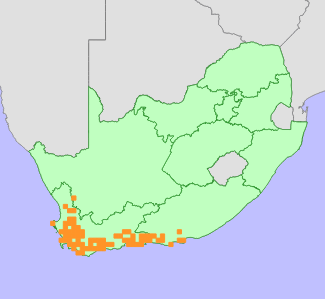| Scientific Name | Printzia polifolia (L.) Hutch. | Higher Classification | Dicotyledons | Family | ASTERACEAE | Synonyms | Aster papposus Willd. ex Spreng., Aster polifolius L., Inula cernua P.J.Bergius, Leysera polifolia (L.) Thunb., Printzia bergii Cass., Printzia cernua (P.J.Bergius) Druce |
National Status | Status and Criteria | Least Concern | Assessment Date | 2020/03/02 | Assessor(s) | L. von Staden | Justification | Printzia polifolia is a widespread and common species, with an extent of occurrence (EOO) of 144 911 km². It is declining across its range, but not yet in danger of extinction, and is therefore listed as Least Concern. |
Distribution | Endemism | South African endemic | Provincial distribution | Eastern Cape, Northern Cape, Western Cape | Range | This species is endemic to South Africa, and is found from the Bokkeveld Escarpment around Nieuwoudtville in the Northern Cape southwards across the Western Cape coastal lowlands to the Cape Flats, and eastwards to Port Elizabeth in the Eastern Cape. |
Habitat and Ecology | Major system | Terrestrial | Major habitats | Breede Shale Fynbos, Olifants Sandstone Fynbos, Kouga Grassy Sandstone Fynbos, Kouga Sandstone Fynbos, South Outeniqua Sandstone Fynbos, South Langeberg Sandstone Fynbos, Cape Lowland Alluvial Vegetation, Kogelberg Sandstone Fynbos, Hawequas Sandstone Fynbos, Garden Route Shale Fynbos, Cederberg Sandstone Fynbos, Cape Winelands Shale Fynbos, North Outeniqua Sandstone Fynbos, Garden Route Granite Fynbos, Boland Granite Fynbos, Elim Ferricrete Fynbos, Cape Flats Sand Fynbos, Knysna Sand Fynbos, Swellendam Silcrete Fynbos, Western Coastal Shale Band Vegetation, Northern Inland Shale Band Vegetation, Swartland Alluvium Fynbos, Elgin Shale Fynbos, Swartland Granite Renosterveld, Eastern Ruens Shale Renosterveld, Swartland Shale Renosterveld, Breede Shale Renosterveld, Swartland Silcrete Renosterveld, Western Ruens Shale Renosterveld, Ruens Silcrete Renosterveld, Central Ruens Shale Renosterveld, Greyton Shale Fynbos, North Langeberg Sandstone Fynbos, Kouebokkeveld Shale Fynbos, Peninsula Granite Fynbos, Langkloof Shale Renosterveld, Overberg Sandstone Fynbos, Kango Limestone Renosterveld, Tsitsikamma Sandstone Fynbos, Atlantis Sand Fynbos, Breede Alluvium Fynbos, Peninsula Sandstone Fynbos, Central Inland Shale Band Vegetation, Central Coastal Shale Band Vegetation, Graafwater Sandstone Fynbos, Potberg Ferricrete Fynbos, Montagu Shale Renosterveld, Suurberg Shale Fynbos, Uniondale Shale Renosterveld, Robertson Granite Fynbos, Nieuwoudtville Shale Renosterveld, Eastern Coastal Shale Band Vegetation, Baviaanskloof Shale Renosterveld, Ceres Shale Renosterveld, Albertinia Sand Fynbos, Agulhas Sand Fynbos, Peninsula Shale Fynbos, Citrusdal Shale Renosterveld, Eastern Inland Shale Band Vegetation, Saldanha Granite Strandveld, Piketberg Sandstone Fynbos, Winterhoek Sandstone Fynbos, South Hex Sandstone Fynbos, Nardouw Sandstone Fynbos, Algoa Sandstone Fynbos, Breede Alluvium Renosterveld, South Kammanassie Sandstone Fynbos, North Kammanassie Sandstone Fynbos, South Swartberg Sandstone Fynbos, Montagu Shale Fynbos, North Rooiberg Sandstone Fynbos, Mossel Bay Shale Renosterveld, South Sonderend Sandstone Fynbos, North Sonderend Sandstone Fynbos, Vanrhynsdorp Shale Renosterveld, Peninsula Shale Renosterveld, Bokkeveld Sandstone Fynbos, Suurberg Quartzite Fynbos, Canca Limestone Fynbos, De Hoop Limestone Fynbos, North Hex Sandstone Fynbos, Agulhas Limestone Fynbos, South Rooiberg Sandstone Fynbos | Description | It occurs on flats and gentle hills, mostly on clay. |
Threats | | Printzia polifolia has lost habitat to urban expansion and agriculture, and currently 48% is already irreversibly modified. Lost continues due to urban expansion and coastal development around Cape Town, the Garden Route and Port Elizabeth. Most remaining subpopulations now persist on small, isolated remnants of lowland fynbos and renosterveld, where it is threatened by competition from alien invasive plants, overgrazing, and inappropriate fire management. |
Population | A large number of recent field observations indicate that this species is still common, in spite of extensive historical habitat loss. As habitat loss and degradation is ongoing, a continuing decline is inferred.
| Population trend | Decreasing |
Assessment History |
Taxon assessed |
Status and Criteria |
Citation/Red List version | | Printzia polifolia (L.) Hutch. | Least Concern | Raimondo et al. (2009) | |
Bibliography | Bullock, A.A. 1948. Printzia polifolia (Linn.) Hutch. Kew Bulletin 3(1):54-55.
Goldblatt, P. and Manning, J.C. 2000. Cape Plants: A conspectus of the Cape Flora of South Africa. Strelitzia 9. National Botanical Institute, Cape Town.
Manning, J.C. and Goldblatt, P. 2012. Plants of the Greater Cape Floristic Region 1: The Core Cape Flora. Strelitzia 29. South African National Biodiversity Institute, Pretoria.
Raimondo, D., von Staden, L., Foden, W., Victor, J.E., Helme, N.A., Turner, R.C., Kamundi, D.A. and Manyama, P.A. 2009. Red List of South African Plants. Strelitzia 25. South African National Biodiversity Institute, Pretoria.
Vlok, J. and Schutte-Vlok, A.L. 2010. Plants of the Klein Karoo. Umdaus Press, Hatfield.
|
Citation | | von Staden, L. 2020. Printzia polifolia (L.) Hutch. National Assessment: Red List of South African Plants version . Accessed on 2025/08/16 |
 Comment on this assessment Comment on this assessment
|
 © D. Turner  © D. Turner  © J.H. Vlok/A.L. Schutte-Vlok  © J.H. Vlok/A.L. Schutte-Vlok  © Outramps
Search for images of Printzia polifolia on iNaturalist
|
 Comment on this assessment
Comment on this assessment


